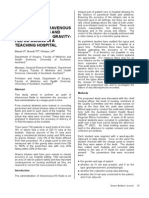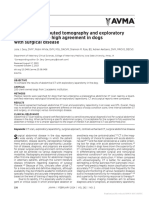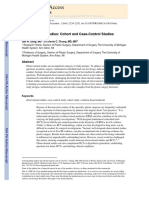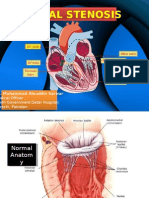Erythrocyte Sedimentation Rate Journey Verifying A New Method For An Imperfect Test
Erythrocyte Sedimentation Rate Journey Verifying A New Method For An Imperfect Test
Uploaded by
Rina ErlinaCopyright:
Available Formats
Erythrocyte Sedimentation Rate Journey Verifying A New Method For An Imperfect Test
Erythrocyte Sedimentation Rate Journey Verifying A New Method For An Imperfect Test
Uploaded by
Rina ErlinaOriginal Title
Copyright
Available Formats
Share this document
Did you find this document useful?
Is this content inappropriate?
Copyright:
Available Formats
Erythrocyte Sedimentation Rate Journey Verifying A New Method For An Imperfect Test
Erythrocyte Sedimentation Rate Journey Verifying A New Method For An Imperfect Test
Uploaded by
Rina ErlinaCopyright:
Available Formats
AJCP / Editorial
Erythrocyte Sedimentation Rate
Journey Verifying a New Method for an Imperfect Test
Jeannette Guarner, MD,1 Hannah K. Dolan, MT(ASCP),2 and Lisa Cole, MT(ASCP)2
From the 1Department of Pathology and Laboratory Medicine, Emory University School of Medicine, Atlanta, GA, and 2 Emory Healthcare, Atlanta, GA.
Am J Clin Pathol October 2015;144:536-538
Downloaded from https://academic.oup.com/ajcp/article-abstract/144/4/536/1766140 by guest on 07 April 2019
DOI: 10.1309/AJCPQO81BGTKTVJJ
The rate of sedimentation of blood-formed elements in the method has to manipulate and pour blood into the
a predetermined amount of time, also known as the eryth- Westergren-Katz tube, the technique is considered to have
rocyte sedimentation rate (ESR), is used around the world a high biohazard risk. Thus, many companies have looked
by many clinicians in an effort to assess acute inflamma- into using methods that are better suited to modern clinical
tory response. ESR results have been incorporated into laboratories.
many practices and algorithms as a way to determine the One of the methods accelerates turnaround time to
presence of active inflammation.1-4 However, ESR is a less than 30 minutes by using the Boycott phenomenon.7
phenomenon that is not well understood since aggrega- For this method, the sample can be obtained directly (by
tion, precipitation, and packing of RBCs are facilitated by using the vacuum) or filled manually into shorter, rect-
many plasma proteins, including fibrinogen and immuno- angular, tapered tubes that are placed in an instrument
globulins, and affected by the amount and shape of RBCs.5 that maintains the temperature and holds them at an 18°
Because this phenomenon lacks specificity, clinical chem- angle to the vertical. The height of the RBCs is measured
ists and pathologists who direct clinical laboratories where using light transmission after the tube has been in place
ESR is measured believe it is a very imperfect test. In for 20 minutes, and a mathematical correction is applied
this editorial, we review how instrumentation in clinical to make the measurement comparable to the Westergren
laboratories has progressed to make it easier, faster, less ESR. Authors have found both favorable and unfavorable
hazardous, and more standardized to perform ESR, and comparisons of the shorter method to the standard refer-
we describe the challenges clinical laboratories encounter ence method.8,9 However, since we do not really know
when verifying fundamentally different technologies that what analytes are being measured with either technique,
measure the ESR phenomenon. why not use the method that offers advantages from the
The ESR testing method was developed by R. S. laboratory standpoint, including less manipulation of the
Fåhræus and A. V. A. Westergren. The original method specimen, smaller sample volume, and decreased turn-
was first described in 1921, and modifications of the around time?
original method have been selected as the reference stan- A second alternative sedimentation rate method that
dard by several agencies.6 In general, this method uses uses rheometry has also made it onto the market. Rheom-
blood that has been anticoagulated and diluted and then etry measures the flow and deformation of materials under
placed in the Westergren-Katz tube, which has to stand applied forces and can be determined on a microscale using
in a strictly vertical position in a rack for 1 hour at room optical techniques as the sample flows in a microcapillary.
temperature. The result is the measurement in millimeters When applying rheometry to determining the ESR, the
of the distance erythrocytes have fallen. This method is instrument uses anticoagulated blood that is sampled directly
manual and has many preanalytical and analytical factors from the tube from which it was drawn (usual tubes used
that can alter results. In addition, as the person performing for other purposes in the laboratory), and multiple optical
536 Am J Clin Pathol 2015;144:536-538 © American Society for Clinical Pathology
DOI: 10.1309/AJCPQO81BGTKTVJJ
AJCP / Editorial
140 laboratory values (WBC counts and C-reactive protein)
and clinical histories (rheumatologic/infectious disease or
120 malignancy). The review included those cases that would
have been within the normal range for one of the methods
Boycott Instrument
100
and elevated for the other. There were a total of 50 cases,
80
but review of the medical record was possible only in 45.
60 There were 25 female patients with discrepant results; in
36%, the method using rheometry could be considered to
40
correlate better according to the medical history. Of the 20
20 male patients, 55% were considered to correlate better with
the method using rheometry. The average difference was
0
20 mm in female patients and 16 mm in male patients, and
Downloaded from https://academic.oup.com/ajcp/article-abstract/144/4/536/1766140 by guest on 07 April 2019
0 20 40 60 80 100 120 140
there were six patients with a difference above 30 mm, with
Rheometry Instrument
one reaching 97 mm. Of these six patients, the method using
❚Figure 1❚ Comparison of 300 samples using the Boycott and rheometry was considered better in two patients. One patient
rheometry instruments. had a renal transplant and the WBC count was normal, and
the second had breast cancer with a normal WBC count
measurements are obtained as the blood flows in the micro- and C-reactive protein. The latter was the patient in whom
tube. The sedimentation curve obtained is transformed to the difference between the sedimentation rates was 97 mm.
comparable Westergren values. Several publications have In the other four patients, the sedimentation rate using the
presented good correlation of the results when comparing Boycott phenomenon was considered better; two patients
these instruments with the reference method.10-13 Advan- had active infections, one had a renal neoplasia, and the last
tages of instruments that use this technology include rapid patient had rheumatoid arthritis and scleroderma. In sum-
results, low imprecision, and performance that can be main- mary, although there are discordant cases when correlating
tained in blood stored for 24 hours. with other laboratory and clinical parameters, one method
The International Council for Standardization in Haema- does not seem to be better than the other.
tology recommends comparisons of new faster methods to We have had no clinical complaints after we imple-
the reference method.6 However, if your laboratory is already mented the ESR that uses rheometry. Technologists are
using one of the faster methods and you want to change to pleased with the new instruments since these are less labor
another method, the capability to compare to the reference intensive. However, the verification process was labor inten-
method will be limited. In the following, we describe the sur- sive, with comparison studies that needed a large amount of
prises encountered while verifying two rheometry instruments subjects and review of medical records of discrepant results,
to an instrument that uses the Boycott phenomenon: in addition to having to establish a new normal range for a
1. The precision studies for the low level had a coefficient specific population.
of variation (CV) between 25% and 28%, although the ESR In this era where health care systems are pressed for
results ranged from 2% to 5% in the rheometry instrument. better utilization, clinicians continue to use tests that were
The high level showed a CV that ranged between 11% and invented in the early 20th century and that measure phenom-
13%, with ESR values that ranged between 30% and 45%. ena that are obscure and have many variables, such as the
2. For the comparison, we used 300 patient samples that ESR. Verification of disparate methods for a phenomenon
ranged from a value of 1 to 130 with an intercept that was that is not due to one specific analyte can prove challenging
less than 1 and an almost perfect slope (1 and 1.08). How- and may require added clinical correlations in addition to the
ever, the dispersion was enormous ❚Figure 1❚. Taking the test usual verification steps.
as normal vs abnormal, 83% of samples were concordant
(28% in the normal range and 55% in the abnormal range)
and 17% discordant. References
3. We were able to verify the normal range for males
1. Castrejón I, Carmona L, Ortiz A, et al. Development and
younger than 50 years (<15 mm) and people older than validation of a new disease activity index as a numerical sum
50 years (<30 mm) with 20 samples each, but for females of four variables in patients with early arthritis. Arthritis Care
younger than 50 years, we had to create a new normal range Res. 2013;65:518-525.
for our population (<25 mm). 2. Anderson J, Caplan L, Yazdany J, et al. Rheumatoid arthritis
disease activity measures: American College of Rheumatology
The amount of dispersion of the correlation results recommendations for use in clinical practice. Arthritis Care
prompted us to study correlation of results with other Res. 2012;64:640-647.
© American Society for Clinical Pathology Am J Clin Pathol 2015;144:536-538 537
DOI: 10.1309/AJCPQO81BGTKTVJJ
Guarner et al / Verifying a New Method for ESR
3. Anderson J, Zimmerman L, Caplan L, et al. Measures of 7. Caswell M, Stuart J. Assessment of Diesse Ves-matic
rheumatoid arthritis disease activity: Patient (PtGA) and automated system for measuring erythrocyte sedimentation
Provider (PrGA) Global Assessment of Disease Activity, rate. J Clin Pathol. 1991;44:946-949.
Disease Activity Score (DAS) and Disease Activity Score 8. Curvers J, Kooren J, Laan M, et al. Evaluation of the
with 28-Joint Counts (DAS28), Simplified Disease Activity Ves-Matic Cube 200 erythrocyte sedimentation method:
Index (SDAI), Clinical Disease Activity Index (CDAI), comparison with Westergren-based methods. Am J Clin
Patient Activity Score (PAS) and Patient Activity Score-II Pathol. 2010;134:653-660.
(PASII), Routine Assessment of Patient Index Data
(RAPID), Rheumatoid Arthritis Disease Activity Index 9. Cerutti H, Muzzi C, Leoncini R, et al. Erythrocyte
(RADAI) and Rheumatoid Arthritis Disease Activity sedimentation rate measurement by VES Matic Cube 80 in
Index-5 (RADAI-5), Chronic Arthritis Systemic Index relation to inflammation plasma proteins. J Clin Lab Anal.
(CASI), Patient-Based Disease Activity Score With ESR 2011;25:198-202.
(PDAS1) and Patient-Based Disease Activity Score without 10. Romero A, Muñoz M, Ramírez G. Length of sedimentation
ESR (PDAS2), and Mean Overall Index for Rheumatoid reaction in blood: a comparison of the test 1 ESR system
Arthritis (MOI-RA). Arthritis Care Res. 2011;63(suppl with the ICSH reference method and the sedisystem 15. Clin
Downloaded from https://academic.oup.com/ajcp/article-abstract/144/4/536/1766140 by guest on 07 April 2019
11):S14-S36. Chem Lab Med. 2003;41:232-237.
4. Aletaha D, Neogi T, Silman A, et al. 2010 Rheumatoid 11. Jonge ND, Sewkaransing I, Slinger J, et al. Erythrocyte
arthritis classification criteria: an American College of sedimentation rate by the test-1 analyzer. Clin Chem Lab
Rheumatology/European League Against Rheumatism Med. 2000;46:881-882.
collaborative initiative. Arthritis Rheum. 2010;62:2569-2581. 12. Plebani M, Piva E. Erythrocyte sedimentation rate:
5. Vennapusa B, De-La-Cruz L, Shah H, et al. Erythrocyte use of fresh blood for quality control. Am J Clin Pathol.
sedimentation rate (ESR) measured by the Streck ESR-Auto 2002;117:621-626.
Plus is higher than with the Sediplast Westergren method: a 13. Ozdem S, Akbas H, Donmez L, et al. Comparison of
validation study. Am J Clin Pathol. 2011;135:386-390. TEST 1 with SRS 100 and ICSH reference method for the
6. Jou J, Lewis S, Briggs C, et al. ICSH review of the measurement of the length of sedimentation reaction in
measurement of the erythrocyte sedimentation rate. Int J Lab blood. Clin Chem Lab Med. 2006;44:407-412.
Hematol. 2011;33:125-132.
538 Am J Clin Pathol 2015;144:536-538 © American Society for Clinical Pathology
DOI: 10.1309/AJCPQO81BGTKTVJJ
You might also like
- (Current Clinical Psychiatry) Oliver Freudenreich - Psychotic Disorders - A Practical (2020) PDF100% (11)(Current Clinical Psychiatry) Oliver Freudenreich - Psychotic Disorders - A Practical (2020) PDF479 pages
- European Journal of Biomedical AND Pharmaceutical SciencesNo ratings yetEuropean Journal of Biomedical AND Pharmaceutical Sciences5 pages
- Open Versus Laparoscopic Cholecystectomy A ComparaNo ratings yetOpen Versus Laparoscopic Cholecystectomy A Compara5 pages
- Diagnostic Performance of The ACR/EULAR 2010 Criteria For Rheumatoid Arthritis and Two Diagnostic Algorithms in An Early Arthritis Clinic (REACH)No ratings yetDiagnostic Performance of The ACR/EULAR 2010 Criteria For Rheumatoid Arthritis and Two Diagnostic Algorithms in An Early Arthritis Clinic (REACH)3 pages
- Comparison of Point-of-Care Measurement of Electrolyte Concentrations On Calculations of The Anion Gap and The Strong Ion DifferenceNo ratings yetComparison of Point-of-Care Measurement of Electrolyte Concentrations On Calculations of The Anion Gap and The Strong Ion Difference8 pages
- Ajol File Journals - 454 - Articles - 84255 - Submission - Proof - 84255 5389 204858 1 10 20130110No ratings yetAjol File Journals - 454 - Articles - 84255 - Submission - Proof - 84255 5389 204858 1 10 201301104 pages
- C-Reactive Protein Trajectory To Predict Colorectal Anastomotic Leak PREDICT StudyNo ratings yetC-Reactive Protein Trajectory To Predict Colorectal Anastomotic Leak PREDICT Study7 pages
- outcomes_of_laparoscopic_versus_open_liver.10No ratings yetoutcomes_of_laparoscopic_versus_open_liver.107 pages
- Hemolysis in Serum Samples Drawn by Emergency Department Personnel Versus Laboratory PhlebotomistsNo ratings yetHemolysis in Serum Samples Drawn by Emergency Department Personnel Versus Laboratory Phlebotomists3 pages
- A Randomized Controlled Trial of Endovascular Aneurysm Repair Versus Open Surgery For Abdominal Aortic Aneurysms in Low - To Moderate-Risk PatientsNo ratings yetA Randomized Controlled Trial of Endovascular Aneurysm Repair Versus Open Surgery For Abdominal Aortic Aneurysms in Low - To Moderate-Risk Patients8 pages
- Feasibility of Performing Treadmill Walking Test For Pati - 2024 - JMV Journal DNo ratings yetFeasibility of Performing Treadmill Walking Test For Pati - 2024 - JMV Journal D8 pages
- Complicaiones de La Ventriculostomia Agosto 2011No ratings yetComplicaiones de La Ventriculostomia Agosto 20116 pages
- Use of Fresh Blood For Quality Control: Erythrocyte Sedimentation RateNo ratings yetUse of Fresh Blood For Quality Control: Erythrocyte Sedimentation Rate6 pages
- A Cross-Sectional Study On Evaluation of Complete Blood Count-Associated Parameters For The Diagnosis of Acute AppendicitisNo ratings yetA Cross-Sectional Study On Evaluation of Complete Blood Count-Associated Parameters For The Diagnosis of Acute Appendicitis6 pages
- Performance evaluation of the BC-720 auto hematology analyzer and establishment of the referenceNo ratings yetPerformance evaluation of the BC-720 auto hematology analyzer and establishment of the reference12 pages
- Preanalytical Variables and Their Influence On The Quality of Laboratory ResultsNo ratings yetPreanalytical Variables and Their Influence On The Quality of Laboratory Results4 pages
- 8 - The Effectiveness of A Routine Versus An Extensive Laboratory Analysis in The Diagnosis of Anaemia in General PracticeNo ratings yet8 - The Effectiveness of A Routine Versus An Extensive Laboratory Analysis in The Diagnosis of Anaemia in General Practice8 pages
- Intra Operative Allowable Blood Loss: Estimation Made Easy: Original Research ArticleNo ratings yetIntra Operative Allowable Blood Loss: Estimation Made Easy: Original Research Article5 pages
- Quantitative CT Features On Admission Combined WitNo ratings yetQuantitative CT Features On Admission Combined Wit8 pages
- Correlation of Serum C-Reactive Protein, White Blood Count and Neutrophil Percentage With Histopathology Findings in Acute AppendicitisNo ratings yetCorrelation of Serum C-Reactive Protein, White Blood Count and Neutrophil Percentage With Histopathology Findings in Acute Appendicitis6 pages
- 04.IFD U3.Esteban - Entornos ConstructivistasNo ratings yet04.IFD U3.Esteban - Entornos Constructivistas8 pages
- Review Article: Pre-Analytical Phase in Clinical Chemistry LaboratoryNo ratings yetReview Article: Pre-Analytical Phase in Clinical Chemistry Laboratory8 pages
- Int J Lab Hematology - 2021 - Kitchen - International Council For Standardization in Haematology ICSH Recommendations ForNo ratings yetInt J Lab Hematology - 2021 - Kitchen - International Council For Standardization in Haematology ICSH Recommendations For12 pages
- Cost Analysis of A Neonatal Point-of-Care MonitorNo ratings yetCost Analysis of A Neonatal Point-of-Care Monitor10 pages
- Bicarbonato y Manitol en Rabdomiolisis Por Trauma 2017No ratings yetBicarbonato y Manitol en Rabdomiolisis Por Trauma 20177 pages
- Hemolyzed Sample Should Be Processed For Coagulation Studies: The Study of Hemolysis Effects On Coagulation ParametersNo ratings yetHemolyzed Sample Should Be Processed For Coagulation Studies: The Study of Hemolysis Effects On Coagulation Parameters2 pages
- Fernandez-Fuertes J. 2022. Clinical Response OA Standardized Closed System Low Cost PRP ProductNo ratings yetFernandez-Fuertes J. 2022. Clinical Response OA Standardized Closed System Low Cost PRP Product11 pages
- Autologous Blood Salvage in Cardiac Surgery: Clinical Evaluation, Efficacy and Levels of Residual HeparinNo ratings yetAutologous Blood Salvage in Cardiac Surgery: Clinical Evaluation, Efficacy and Levels of Residual Heparin8 pages
- A Study of Clinical Presentations and Management oNo ratings yetA Study of Clinical Presentations and Management o4 pages
- Journal of Cardiothoracic and Vascular Anesthesia: Original ArticleNo ratings yetJournal of Cardiothoracic and Vascular Anesthesia: Original Article11 pages
- Case Study #5 Gravida 2 para 1: Here Starts The Presentation!No ratings yetCase Study #5 Gravida 2 para 1: Here Starts The Presentation!45 pages
- Personalised Human Albumin in Patients With Cirrhosis and Ascites: Design and Rationale For The ALB-TRIAL - A Randomised Clinical Biomarker Validation TrialNo ratings yetPersonalised Human Albumin in Patients With Cirrhosis and Ascites: Design and Rationale For The ALB-TRIAL - A Randomised Clinical Biomarker Validation Trial8 pages
- Perioperative Reliability of An On-Site Prothrombin Time Assay Under Different Haemostatic ConditionsNo ratings yetPerioperative Reliability of An On-Site Prothrombin Time Assay Under Different Haemostatic Conditions4 pages
- NICAS Monitoring in TURP Case PPT 25122No ratings yetNICAS Monitoring in TURP Case PPT 2512227 pages
- Determination of Perioperative Blood Loss .43No ratings yetDetermination of Perioperative Blood Loss .437 pages
- Liu Et Al 2015 Comparison of Multislice Computed Tomography and Clinical Scores For Diagnosing Acute AppendicitisNo ratings yetLiu Et Al 2015 Comparison of Multislice Computed Tomography and Clinical Scores For Diagnosing Acute Appendicitis9 pages
- Application of the Scientific Method.edited (1)No ratings yetApplication of the Scientific Method.edited (1)5 pages
- Quick guide to Laboratory Medicine: a student's overviewFrom EverandQuick guide to Laboratory Medicine: a student's overviewNo ratings yet
- COVID-19: Immunopathogenesis and Immunotherapeutics: Signal Transduction and Targeted TherapyNo ratings yetCOVID-19: Immunopathogenesis and Immunotherapeutics: Signal Transduction and Targeted Therapy8 pages
- Ferritin in The Coronavirus Disease 2019 (COVID-19) : A Systematic Review and Meta-AnalysisNo ratings yetFerritin in The Coronavirus Disease 2019 (COVID-19) : A Systematic Review and Meta-Analysis18 pages
- Recovery/bias Evaluation: Ivo Leito University of Tartu Ivo - Leito@ut - EeNo ratings yetRecovery/bias Evaluation: Ivo Leito University of Tartu Ivo - Leito@ut - Ee18 pages
- What'S New in Treatment Monitoring: Viral Load and Cd4 TestingNo ratings yetWhat'S New in Treatment Monitoring: Viral Load and Cd4 Testing2 pages
- Review Article: Thyrotoxic Periodic Paralysis: Clinical ChallengesNo ratings yetReview Article: Thyrotoxic Periodic Paralysis: Clinical Challenges7 pages
- Case Report: Lauren Hayley Stieger Clarine, DO Nadeen Hosein, MDNo ratings yetCase Report: Lauren Hayley Stieger Clarine, DO Nadeen Hosein, MD5 pages
- Thyrotoxic Periodic Paralysis: An Endocrine Cause of ParaparesisNo ratings yetThyrotoxic Periodic Paralysis: An Endocrine Cause of Paraparesis2 pages
- Oxacillin Resistant Staphylococcus Aureus Among Hiv Infected and Non-Infected Kenyan PatientsNo ratings yetOxacillin Resistant Staphylococcus Aureus Among Hiv Infected and Non-Infected Kenyan Patients8 pages
- An Insight Into The Ethical Issues Related To in Vitro FertilizationNo ratings yetAn Insight Into The Ethical Issues Related To in Vitro Fertilization5 pages
- (Hepatology Research and Clinical Developments) Miranda L. Michelli-Liver Cirrhosis - Causes - Diagnosis and Treatment (Hepatology Research and Clinical Developments) - Nova Science Pub Inc (2011) PDF100% (2)(Hepatology Research and Clinical Developments) Miranda L. Michelli-Liver Cirrhosis - Causes - Diagnosis and Treatment (Hepatology Research and Clinical Developments) - Nova Science Pub Inc (2011) PDF303 pages
- The Importance of Keeping Good Medical RecordsNo ratings yetThe Importance of Keeping Good Medical Records3 pages
- Dr. Ayushi Verma, BDS: Professtional SummaryNo ratings yetDr. Ayushi Verma, BDS: Professtional Summary2 pages
- 5F Hourglass™: Post Clearance - Clinical Observation StudyNo ratings yet5F Hourglass™: Post Clearance - Clinical Observation Study4 pages
- Endometrial Cancer Early Detection, Diagnosis, and StagingNo ratings yetEndometrial Cancer Early Detection, Diagnosis, and Staging16 pages
- ACG Clinical Guideline Gastroparesis.15No ratings yetACG Clinical Guideline Gastroparesis.1524 pages






































































































